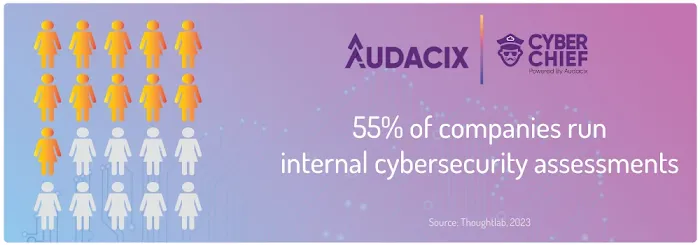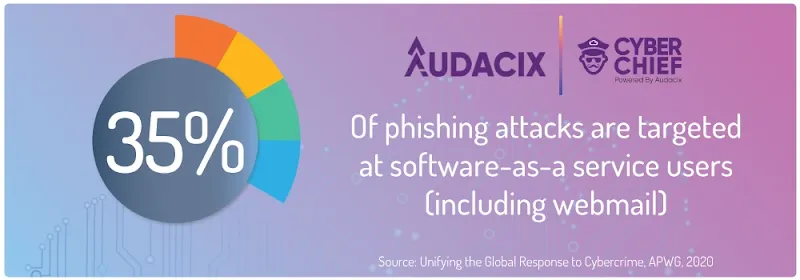Conducting an online pentest will help you minimize the risk posed by cybercriminals who exploit vulnerabilities to gain control over your web applications and APIs.
It turns out that more than half of your peers are already conducting these assessments in-house:

Online or web pentest tools are also called automated penetration testing tools or web app vulnerability scanning tools and they simulate automated attacks on your web app and APIs, without requiring you to install any software on your network or workstations!
I'm going to reveal to you a specific automated penetration testing tool that not only helps you discover security issues, but it's one that is actually built to be used by your software development team without any help from expensive security consultants.
This Cyber Chief online pentesting tool actually helps your devs become more than they are.
What is online pentesting & how does it help SaaS companies?
Online penetration testing is an automated hacker-style attack aimed at identifying vulnerabilities in your web application, its operating system and underlying infrastructure.
Online pentesting tools perform what is commonly referred to as a vulnerability assessment on your web application and APIs.
Top SaaS companies that employ online pentesting platforms are able to not only fix their security flaws, but also prove to their customers, partners and investors that they are a trustworthy business.
.jpg)
Naturally, this increased trust helps to close more deals, faster, because security is a key factor in enterprise purchasing decisions.
Can I pentest my own web application?
Yes, you can pentest your web application and APIs, by running online or automated penetration testing tools such as Cyber Chief.
Years ago, you had to hire experienced security professionals to do penetration testing on your web application and APIs.
Thanks to new AI-based web pentest tools like Cyber Chief, you can conduct many of these security tests as part of your software development workflow, without relying on expensive security consultants.

How do you automate penetration testing?
Automated penetration testing should become a priority on your list of security best practices. It is no longer an optional element of your software development workflow.
It is simple! You only need an online penetration tool. And in this case, we will take Cyber Chief as an example to help us understand this concept.
With Cyber Chief online penetration testing tool, your developers don't need any cybersecurity experience to find and fix vulnerabilities in your SaaS applications, database servers and APIs.
It integrates into your software deployment pipelines to automatically scan all your environments (eg. production, testing, staging, etc).
That way, your web application will have near-zero vulnerabilities every time you ship a new version. Besides, Cyber Chief is a vulnerability scanning tool eases your team's work and increases productivity while identifying and sealing all security loopholes with every line of code typed.
What type of security testing do automated penetration testing tools perform?
Online or automated penetration testing tools mainly perform gray box and black box tests. But what do these two terms mean?
From the name, black box testing is where the login credentials of your web application are uknown to the pentesting tool.
On the other hand, gray box testing involves auditing your application for vulnerabilities both as an unauthenticated user and an authenticated user.

Ideally you should be running gray box or authenticated security tests on your application and APIs because this is going to give you the core impact you're looking for.
Why? Because attackers are succesfully stealing login credentials from your users. So you need to make sure that when an attacker hacks your application, they do as little damage as possible.
However, a best-practice security structure also requires white-box testing to identify vulnerable lines of code in your codebase. You need a static vulnerability scanner for this if you want to do this testing on a regular basis as part of your code commits.
It can also be performed as part of an in-depth manual penetration testing as a service process.
Can all online penetration testing tools be used by developers?
It is tempting to say yes, but unfortunately, the answer is no. Most automated penetration testing tools were designed for cybersecurity experts who are qualified to do a web application penetration test.
These experts have cybersecurity training and penetration testing expertise that most developers do not.
Because older "brand-name" tools, like Metasploit and Burp Suite, require experience to set up and use, most software engineers do not use these online pentesting tools because they feel that it slows down their web application development process.
Imagine asking a dentist to drill a road using a jackhammer! Just because they use one type of drill in their work, doesn't mean they can use every type of drill in existience.
That's just how devs feel when they're forced to use an unsuitable pentesting tool.

Does that mean you should not introduce an automated penetration testing tool?
No. Because new automated penetration testing tools, like Cyber Chief, solve this very problem and help software development teams shift left with security.
For example, Cyber Chief is an online penetration testing tool that has been built especially for software developers to use within their software development workflows.
In fact, it is so frictionless and user-friendly that instead of slowing down your application development process, Cyber Chief seamlessly integrates into your code deployment pipelines to ensrue that your developers spend as little time on your automated penetration tests as is absolutely needed.
This means your developers find and fix security vulnerabilities without having to rely on security professionals.
Your developers literally become more than they are and receive the on-the-job coaching to ship your web application with zero known vulnerabilities in the process.
Can an online penetration testing tool replace a manual penetration test?
But contrary to wishful thinking popular belief, and despite the
increased application of ML and AI technologies, online pentesting tools
can only achieve about 55-60% of the results found during a manual penetration testing process.
The reason for this is that automated pentesting tools struggle to think like a human. They don't have the creativity of an attacker to find hidden business logic-related vulnerabilities.
Therefore, it's critical that your best-practice security application cyber security process includes a pentest report from a highly-regarded pen testing company like Audacix.

Can automated penetration testing tools also perform vulnerability assessments?
Yes, essentially the output of an automated penetration testing tool is referred to as a vulnerability assessment.
These automated penetration tests are often confused with manual web application security testing which is undertaken by highly-skilled security experts.
However, most pen testing tools are designed to only tell you what is wrong with your software and APIs, not how to fix those security vulnerabilities.
They are built for a cyber security penetration tester So if you use those tools, you will be forced to rely on those experts to help you understand what needs to be fixed. And most importantly, what the best practices fixes are.
Naturally, there is a lot of friction in this process.
As a software development leader, you need a tool that helps your developers find and fix vulnerabilities. And that should be done without always having to rely on expensive external security consultants.
Fortunately, tools such as Cyber Chief exist to help you solve this problem because it:
- Is an automated penetration testing tool.
- Provides detailed fixes for security issues, including code snippets.
- Can run without anyone from your team ever needing to click a button.
- Assess your application at runtime through the user interface or via headless modes.
As a result, using Cyber Chief helps you to save both money and many hours of developer productivity over time.
How?
I mentioned patching a security vulnerability is time-consuming and may take your software engineers many hours or days to find the right fix on Google.
Well, that’s not the case if your team uses Cyber Chief.
Cyber Chief saves many person-weeks of developer productivity over time and also ensures that best-practice fixes are applied to the application because it provides detailed vulnerability fixes, including code snippets, where possible.

Can a network vulnerability scanner also find vulnerabilities in web applications and APIs?
In short, no.
Many network scanners also talk about scanning web application but simply cannot perform crucial penetration tests behind an application's login to find critical security weaknesses.
Naturally, this will leave your web application users vulnerable to data breaches from common vulnerabilities like SQL injection and cross site scripting, just to name a couple.
Network scanners ensure your broader corporate network is secure and network and endpoint security.
However, the best web app vulnerability testing tools specialize in helping you find and fix security your web application vulnerabilities. They do this by performing vulnerability scans behind your app's login and ensuring your APIs are free of security holes.
What is the difference between network security scanners and vulnerability scanning tools for web apps and APIs?
I use the analogy of MRI and X-ray to comprehend this difference: both techniques reveal the internal body structure but show different results.
An X-ray mainly identifies bone fractures, dislocations, misalignment, or narrowed joint spaces. On the other hand, an MRI gives more detailed body structures, including soft tissues, nerves, and blood vessels.
Here, the network scanner is just a reconnaissance tools, like an X-Ray, and web application penetration testing tool like Cyber Chief or the open source Zed Attack Proxy is the MRI.
Just as you cannot substitute an X-Ray with an MRI, you shouldn't rely on endpoint or network vulnerability scanners to help you find OWASP Top 10 vulnerabilities in your web application and APIs.
What security vulnerabilities does an automated penetration test tool find?
Cyber Chief is an automated penetration test tool that can find thousands of vulnerabilities in your web application, APIs, and cloud network through its various vulnerability scans.
However, as a software development leader, you're most interested in protecting your application from vulnerabilities in the OWASP Top 10 list. A more detailed list of vulnerabilities is offered by the SANS CWE 25 and includes the vulnerabilities like these:
CWE-787: Out-of-bounds Write
This vulnerability allows the software to write data past the end or before the beginning of the intended buffer. This can lead to undefined or unexpected results, typically causing data corruption or crashes.
CWE-79: Improper Neutralization of Input During Web Page Generation ('Cross Site Scripting')
The cross site scripting vulnerability occurs when the application does not neutralize a user-control input properly before being replaced in the output. This can lead to many problems, including untrusted or incorrect data types in the database and can be exploited across our attack surface.
CWE-89: Improper Neutralization of Special Elements used in an SQL Command ('SQL Injection')

As the name implies, security testing tools construct a SQL query using externally-influenced data input, causing SQL injection vulnerabilities.
SQL injection vulnerabilities are usually easy to fix, but if exploited, can prove to be disastrous in terms of the magnitude of the data breach.
CWE-20: Improper Input Validation
This vulnerability happens when the application fails to validate or incorrectly validate input data. Find more details at mitre.org.
CWE-125: Out-of-bounds Read
As the name implies, this vulnerability occurs when the application reads data past the end or before the beginning of the intended buffer. It allows hackers to access sensitive information and may also cause crashes.
CWE-78: Improper Neutralization of Special Elements used in an Operating Systems Command ('OS Command Injection')
The application constructs an operating system command using externally-influenced input from an upstream component without or incorrectly neutralizing elements that may modify it.
CWE-416: Use After Free
This vulnerability can cause a crash, unexpected values, or even remote code execution.
CWE-22: Improper Limitation of a Pathname to a Restricted Directory ('Path Traversal')
A program can use an external pathname intended for a file or folder underneath a restricted directory without improperly neutralizing it.
CWE-352: Cross-Site Request Forgery (CSRF)
This is defined by the application’s failure to sufficiently verify whether a well-formed, valid, or consistent request was intentionally provided by the correct user who submitted it.

CWE-434: Unrestricted Upload of File with Dangerous Type
The vulnerability allows a hacker to upload through a web browser or transfer malicious executable files that can run within the program’s environment. Naturally, you don't want any malicious uploads in your software flows.
CWE-476: NULL Pointer Dereference
This happens when an application dereferences a pointer expected to be valid but null, causing a crash or unexpected exit.
CWE-502: Deserialization of Untrusted Data
The application deserializes untrusted data without ensuring the validity of the expected outcome.
CWE-190: Integer Overflow or Wraparound
The software performs calculations that yield an integer flow when the resulting value is assumed to be larger. This can cause other weaknesses or introduce errors within the program.
CWE-287: Improper Authentication
The program fails to correctly or sufficiently verify users.
CWE-798: Use of Hard-coded Credentials
The application contains hard-coded credentials for inbound or outbound communication to external components.
CWE-862: Missing Authorization
The failure of an application to authorize users when they attempt to access resources or perform an action. Not all web vulnerability scanners will detect these security vulnerabilities. These security problems are generally picked up in a pen test.
CWE-77: Improper Neutralization of Special Elements used in a Command ('Command Injection')
These security problems occur when your software constructs all or part of a command using externally-influenced input without neutralizing the elements.
CWE-306: Missing Authentication for Critical Function
The application fails to authenticate for functionality that requires a provable user identity. It may also use significant amounts of resources when it should not.
CWE-119: Improper Restriction of Operations within the Bounds of a Memory Buffer
The program writes or reads data from a memory buffer when it can do the same to a memory location outside the intended boundary of the buffer.
CWE-276: Incorrect Default Permissions
This happens when the program allows anyone to modify installation files. It usually occurs during software installation.
CWE-918: Server-Side Request Forgery (SSRF)
The web server fails to verify that the received URL or similar request goes to the appropriate destination.
CWE-362: Concurrent Execution using Shared Resources with Improper Synchronization ('Race Condition')
This is a security concern when the synchronization is in security-critical code, including recording whether or not a user is authenticated or modifying important state information that an outsider should not change.
CWE-400: Uncontrolled Resource Consumption
This happens when your web application fails to control resource allocation, maintenance, and consumption. This allows an outsider to influence resource usage, which can eventually exhaust them.
CWE-611: Improper Restriction of XML External Entity Reference
This vulnerability causes your web application to process an XML document with XML entities with URIs that resolve to documents outside of the intended sphere of control.
CWE-94: Improper Control of Generation of Code ('Code Injection')
The web vulnerability scanner uses external input to construct all or part of the code segment without properly neutralizing it.
What are the key differences between open source web application security tools and paid pentesting tools?
Free web application security tools may seem the best option because of the cost. However, they often require a lot of customization to meet your requirements.
And only people with cybersecurity experience and credentials can undertake this customization. Without this experience, using them is practically impossible. That's why the initial cost advantage of open source penetration testing tools, like OWASP's Zed Attack Proxy (ZAP), usually disappears very quickly.

On the other hand, commercial penetration testing tools like Cyber Chief is designed to be used by software developers. It is straightforward to deploy and use, even if your developers have zero cybersecurity skills or accreditations. And it still allows you to implement critical web app security controls.
Before you choose the right automated penetration test tool for your team read our guide to the best web app pentesting tools and consider the following factors to make the best decision:
-
You ideally need both a dynamic and static scanner to identify vulnerable code and attack surfaces in your web application during runtime.
-
If you want to shift left with security then your tool must provide fixes with code snippets where possible.
-
Your tool should be able to perform pen testing on your APIs.
-
An vulnerability management system that can detect vulnerabilities and automatically manage them, including false positives, to help developers assign accountability, collaborate and prioritize the bugs that need to be fixed first.
-
Choose an easy-to-use vulnerability scanner that runs vulnerability scans right from your DevOps code deployment pipelines.
-
Would you better off with a cloud-based, "agentless" application vulnerability scanner to eliminate installation and licensing headaches.
How Can I Improve My Application Security Posture?
Ideally, your web application and APIs should have continuous security checks throughout the development cycle to identify all vulnerabilities.
But how can you do that?

A minimum best-practice AppSec structure for SaaS companies includes these 5 non-negotiable components:
Deploying a web application firewall (WAF)
Static scanning using a tool like Whitesource
Dynamic vulnerability testing using a tool like Cyber Chief
Manual web application penetration test performed by accredited penetration tester
Cloud portal penetration tests to reduce your attack surface using a tool like Cyber Chief
Putting the right application-specific cyber security structure in place will lead you towards building a culture of security within your software development team.
Can I get an online pentest tool free trial?
The answer is yes. Start your Cyber Chief 14-day free trial today.





